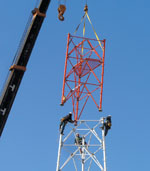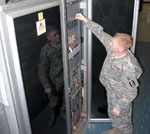Programs Pull Korea Into Communications Future
 |
| Workers install a microwave tower at Kunsan Air Base, Korea, as part of the Product Manager, Defense Wide Transmission Systems’ Digital Microwave Upgrade program. |
The U.S. Army is overhauling its communications in
The Korea Optical Fiber Backbone Replacement (KOBR) program, the Korea Optical Transmission Network (KOTNet) program and the Digital Microwave Upgrade (DMU) program are being implemented in the U.S. Forces Korea area of responsibility through a partnership between the Regional Chief Information Office-Korea, which is part of the Army’s Network Enterprise Technology Command, and the Product Manager, Defense Wide Transmission Systems (PM DWTS). The product manager is part of the Army’s Program Executive Office, Enterprise Information Systems’ Project Manager, Defense Communications and Army Transmission Systems. Soldiers, airmen and civilians from the 1st Signal Brigade, 251st Signal Detachment, 6th Signal Command, 36th and 41st signal battalions, and 51st and 8th communications squadrons also assist the programs, working on site preparation, site safety, quality assurance testing, network configuration, and circuit and system activation.
The three programs replace aged and unsupportable optical fiber, microwave radios and optical transport. The Army’s objective for the work is to ensure path and installation survivability and information security with a system that is scalable, interoperable and supportable over the next decade and beyond. Officials with the military branch say objectives are being achieved.
Operating together, KOBR, KOTNet and the DMU provide the architectural framework for an integrated telecommunications system, traversing a meshed transmission system through the Korean peninsula. They create the meshed telecommunication architecture from the Demilitarized Zone at the North Korean border south to
KOBR provides the architectural framework to replace and build out the fiber optic cable backbone connectivity and installation survivability among U.S. Forces Korea installations. The program includes the installation of fiber cable designed for dense wavelength division multiplexing (DWDM) ultrahigh bandwidth capacity. This cable supports all classifications and speeds of U.S. Forces Korea voice, data and video communications.
The Army is implementing KOBR in five stages to replace pre-1990s long-haul fiber, build out fiber to installations to improve installation survivability and provide capabilities to installations not covered by long-haul fiber. The long-haul fiber formerly in place was not sufficient for the ultrahigh bandwidth needs of the 21st century warfighter. Phases one through three of the program replaced the original fiber optic cable system. That work started in 2002 and was completed in 2007. Phases four and five will build out the backbone to additional locations and should be complete in 2012.
The KOTNet program involves the architecture that adds additional efficiencies and redundancy by optimizing the usage of the KOBR fiber. It allows dedicated through-paths, ultra bandwidth client signals, any-to-any connections and terabit aggregate signals. The KOTNet program provides the architectural framework necessary for optical transport and switching across the transmission infrastructure among the U.S. Korean installations. KOTNet and KOBR are closely related, with KOTNet encompassing the optical network equipment and KOBR serving as the optical fiber backbone. “They go hand in hand,” Gary McIlwain, project leader for all three programs, explains.
KOTNet replaced the aged 1980s optical equipment by installing Synchronous Optical Networking (SONET), DWDM and Raman amplifiers, which are devices that boost the signal in an optical fiber by transferring energy from a powerful pump beam to a weaker signal beam. The DWDM adds an overlaying, transparent, photonic layer to the existing infrastructure by pushing the SONET layer deeper toward the edge of the network. At the same time, it maintains all the efficiencies and benefits of the optical networking.
According to Dan Baker, the principle architect for transmission systems and the in-country project manager and integrator for transmission systems, KOTNet provides network reliability by being able to be provisioned with dual-node interconnect. “This connection scheme allows for the joining of the different rings in two physical nodes and locations,” he says. “Thus, if a fiber cut or disaster [occurs] at one location, the other node will then continue to flow traffic from ring to ring without maintenance intervention.”
Another enhancement is the provision of an offload of high-speed signals from the SONET that do not need to be terminated at each site between the A to Z endpoints. With SONET, even when equipped with high-power, erbium-doped fiber amplifiers, signals must be regenerated at each site, placing additional cost on each circuit.
KOTNet, like KOBR, supports all forms, classifications and speeds of U.S. Forces Korea communications. The optical transmission program is designed to support user high-speed transport and capacity from 10 gigabits to 100 gigabits, ultra-long reach capability and optical ring switching. These features ensure the system’s survivability.
KOTNet is being implemented in two parts with six total phases. Three phases implement the network; they were started in 2004 and completed in 2007. The final three phases enhance the network. That effort began this year and is scheduled for completion in 2012. The first part of KOTNet implemented 22 SONET nodes at 18 locations throughout the Korean peninsula. Part two—the enhancement phases—will implement the DWDM and Raman amplifiers at the SONET locations, increasing bandwidth, optical pass-through and long-reach capability.
As the network evolves, the DWDM will be equipped with Reconfigurable Optical Add and Drop Multiplexer technology that allows the network to be configured as a ring and physical/logical mesh architecture. “Thus, the DWDM equipment provides a core underlay for higher-level protocols to be transported,” explains Lt. Col. Clyde Richards,
The DMU program integrates with KOTNet and also offers survivability through the meshed telecommunication architecture. The program replaces and expands the digital microwave radio connectivity available at
 |
| Staff Sgt. Nathaniel Bradbury, USA, runs diagnostics on an asynchronous transfer mode switch that the Product Manager, Defense Wide Transmission Systems installed at Camp Carroll, Korea, under the Digital Microwave Upgrade program. |
Microwave transmissions can be used in areas where fiber lines cannot be run and also can offer a less expensive solution. Microwave, unlike fiber, does not require personnel to dig and then lay the infrastructure for its use. Tying in microwave with fiber overcomes barriers, such as the mountainous terrain and deep jungles found on the Korean peninsula, that inhibit the establishment of fiber lines. Those same geographical features make survivability important in the systems because of the difficulty inherent in reaching them for repair work.
Though KOBR includes separate fiber lines so security and redundancy is built in, use of microwaves in
Overall, the networks technically will be capable of operating at single aggregated lambdas of 2.5, 10, 40 and 100 gigabits per second, or low speed signal aggregation to ultrahigh speed aggregation. KOTNet is designed to operate at operational bandwidth of 1.6 terabits. The programs offer the combatant commander and the component services higher bandwidth and better path diversity.
The three programs constitute the architectural framework for the implementation of a meshed ring topology operating across an advanced fiber optic cable. They will support ultrahigh bandwidth optical switching through the transmission infrastructure. “The optical switching, multiple rings and integration of the digital microwave form a meshed transmission architecture designed for immediate information restoral without user disruption,” Col. Richards explains.
The total transmission system offers connectivity among
The up-to-the-minute data enables leadership to react better to aggression or catastrophic threats, and component services will obtain the command and control to process necessary intelligence. Linda Bartosik, the team leader for the three networks’ implementation, says that with the new system, commanders will have significantly more intelligence at their disposal than they did previously.
The implementation of the new networks in
McIlwain says that the solution being implemented on the peninsula is right in line with where the Army wants to go and is well-planned for troops’ needs. The programs are based on a 10-year implementation, and the Army wants to make everything interoperable so it meets the network’s full requirements. By completing the work in a timely fashion, warfighting units in
Part of the planning effort involved in the programs was incorporating the different phases and cutover from the old methods to the new systems without any major downtime or impact on warfighters. And though the programs offer faster services and better capabilities to
The work that PM DWTS is carrying out in
Once all phases of KOBR, KOTNet and the DMU are complete, PM DWTS will transfer them to control of U.S. Forces Korea.
Web Resources
Product Manager, Defense Wide Transmission Systems: www.eis.army.mil/dcats/dwts.html
Kunsan Air Base: www.kunsan.af.mil




Comments